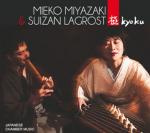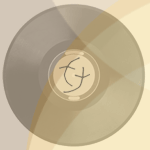Shop

What is currently called «Japanese traditional music» comes from a period of peace between the seventeenth and nineteenth centuries. Some classics from this repertoire are presented in Kyoku. the new Cd by Mieko MIYAZAKI, koto, and Suizan LAGROST, shakuhachi.
Japanese traditional music varies greatly depending on its rural or urban origins. Music from the cities is that which is played in theatre productions and chamber music halls. For this album the artists choose some virtuostic works, favorite concert pieces from the seventeenth through the nineteenth centuries. Some more recent masterpieces composed for the international audience and known for their technical difficulty are also presented.
What is currently called «Japanese traditional music» comes from a period of peace between the seventeenth and nineteenth centuries. Some classics from this repertoire are presented in Kyoku. the new Cd by Mieko MIYAZAKI, koto, and Suizan LAGROST, shakuhachi.
Japanese traditional music varies greatly depending on its rural or urban origins. Music from the cities is that which is played in theatre productions and chamber music halls. For this album the artists choose some virtuostic works, favorite concert pieces from the seventeenth through the nineteenth centuries. Some more recent masterpieces composed for the international audience and known for their technical difficulty are also presented.
The koto came to Japan from China in the eighth century. It was part of the gagaku (Imperial court) orchestra and later enjoyed popularity in the sixteenth century thanks to blind performers. It has 13 strings and belongs to the family of zithers. The soundboard is made of paulownia wood. The koto is tuned by sliding movable bridges (ji) and played with ivory picks (tsune).
The shamisen is a three-stringed instrument belonging to the lute family. The body, made of quince wood, is covered with cat or dog skin. The player uses a fan-shaped pick (bachi) to pluck the strings. Originating in China, it was introduced in Japan in the fifteenth century via Okinawa, at the southern tip of Japan.
The shakuhachi was probably introduced into Japan several times from China and Korea. It is a 5-holed vertical bamboo flute either coated on the inside with lacquer (jiari) or left unvarnished (jinashi). The most common length, 54.5 cm, or 1 shaku and 8 sun, gave the instrument its name. Shakuhachi today is the generic name for instruments of all sizes, the most common ones measuring 1.8 shaku, 1.6 shaku, or 2.4 shaku. The successive opening of the 5 holes produces a pentatonic scale, the intermediary notes being obtained by partially closing the holes and by the characteristic meri-kari technique (varying the angle of attack).
Born in Tokyo, Mieko MIYAZAKI started studying the Japanese koto, as well as the shamisen, with Tomizo Huruya and Sachiko Tamura, she graduated in 1992. Moving to France in 2005, her European career began immediately after her arrive. She has been recognized worldwide as one of the leading figures in Japanese koto.
French-born flutist Suizan J.-F. LAGROST studied concert flute in Mulhouse and Paris with Isabelle Froesch-Papirer, Daniel Morlier, Geneviève Amar, Vicens Prats and Michel Rousseau. He began shakuhachi in 2000 with Grand Master Sōzan Kariya, eminent representative of Tozan School. Mitsuko Nakao, awarded him seven years later the title of Shihan (master). Suizan LAGROST enjoys an international career in traditional, contemporary or mixed repertoires.

Musicians
Mieko Miyazaki - koto
Suizan Lagrost - shakuhachi
HQ Image
Our Playlist
Our olaylist on Spotify, dedicated to P
re Minimalism, Minimalism and Post Minimalism.
Search

































